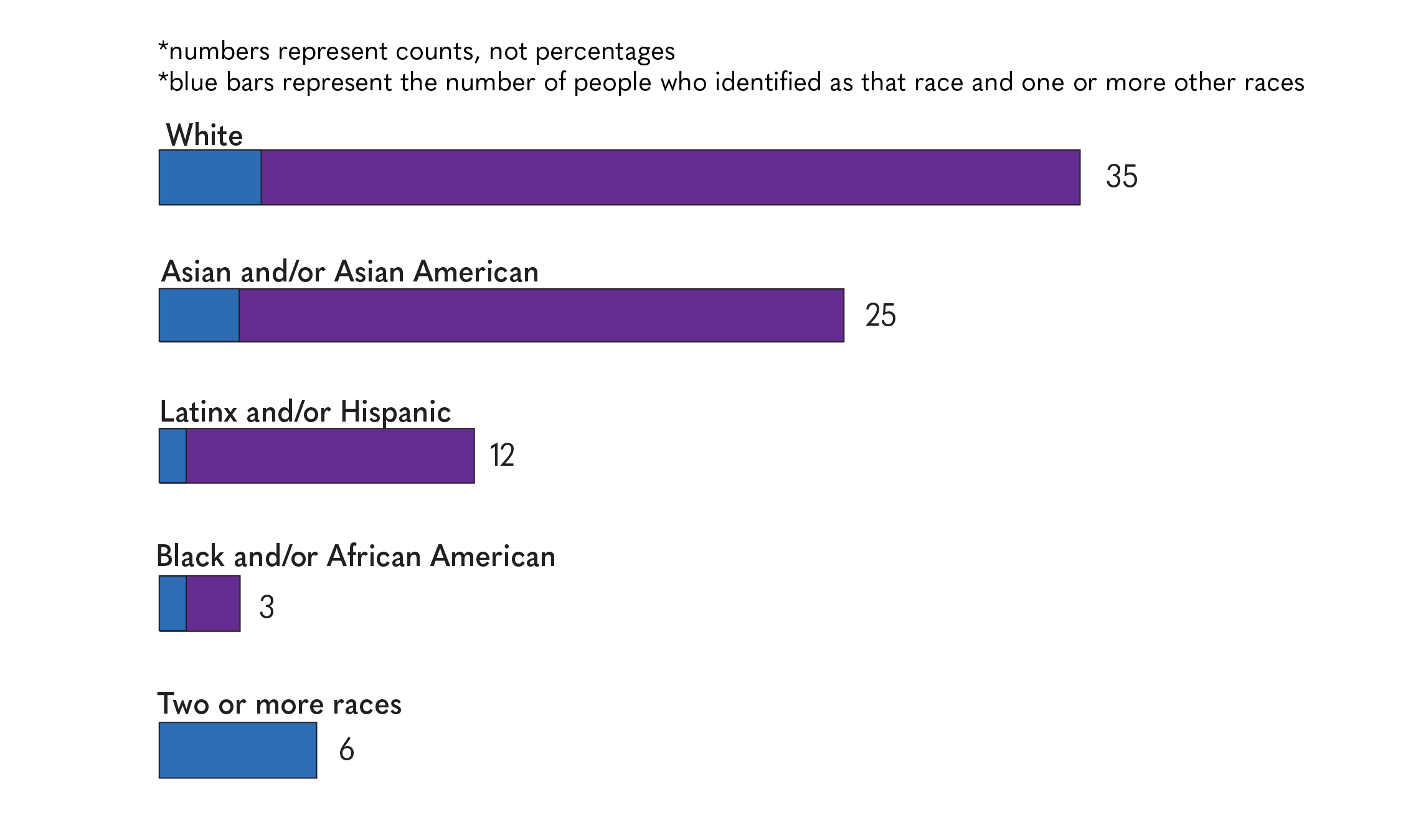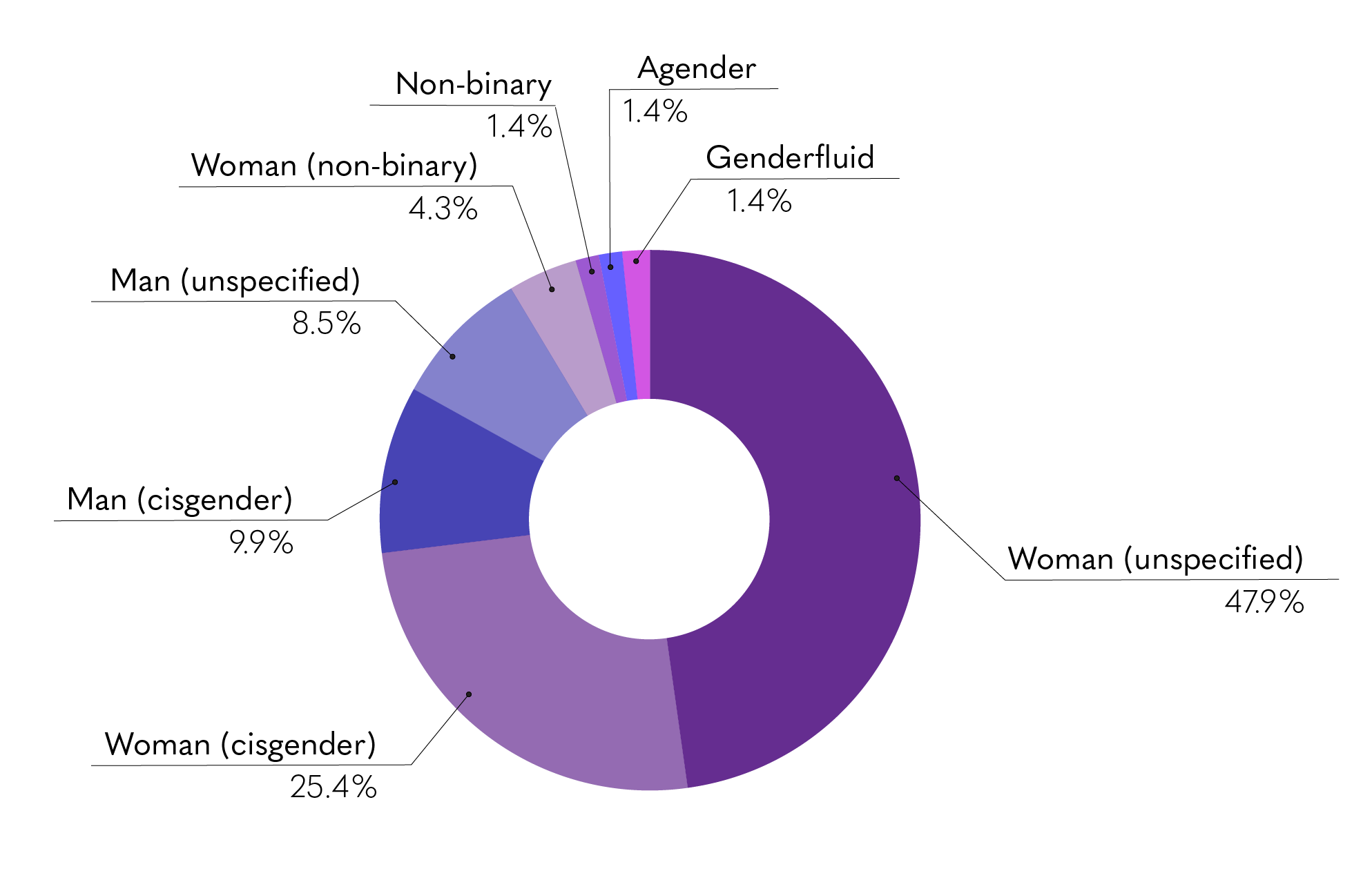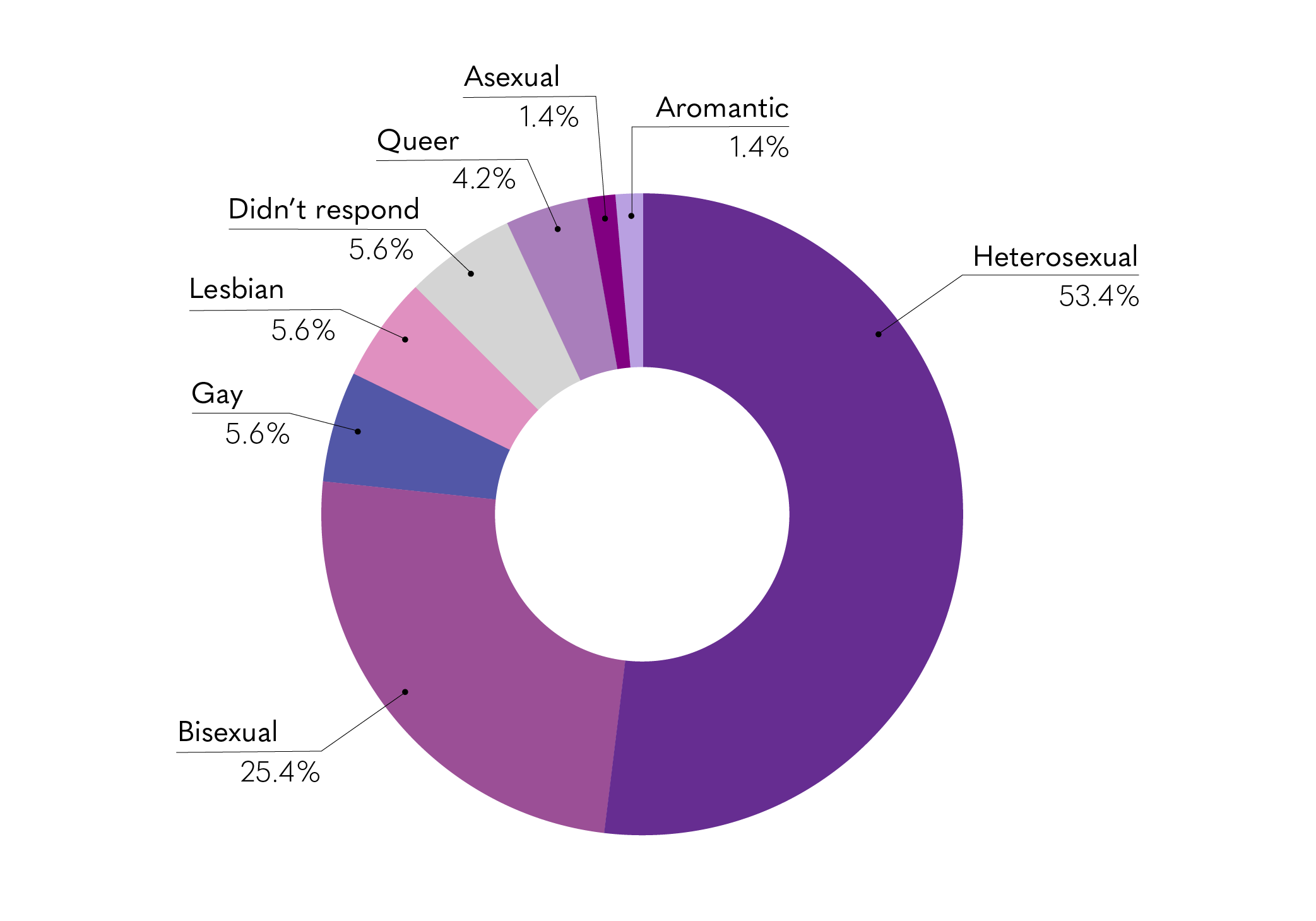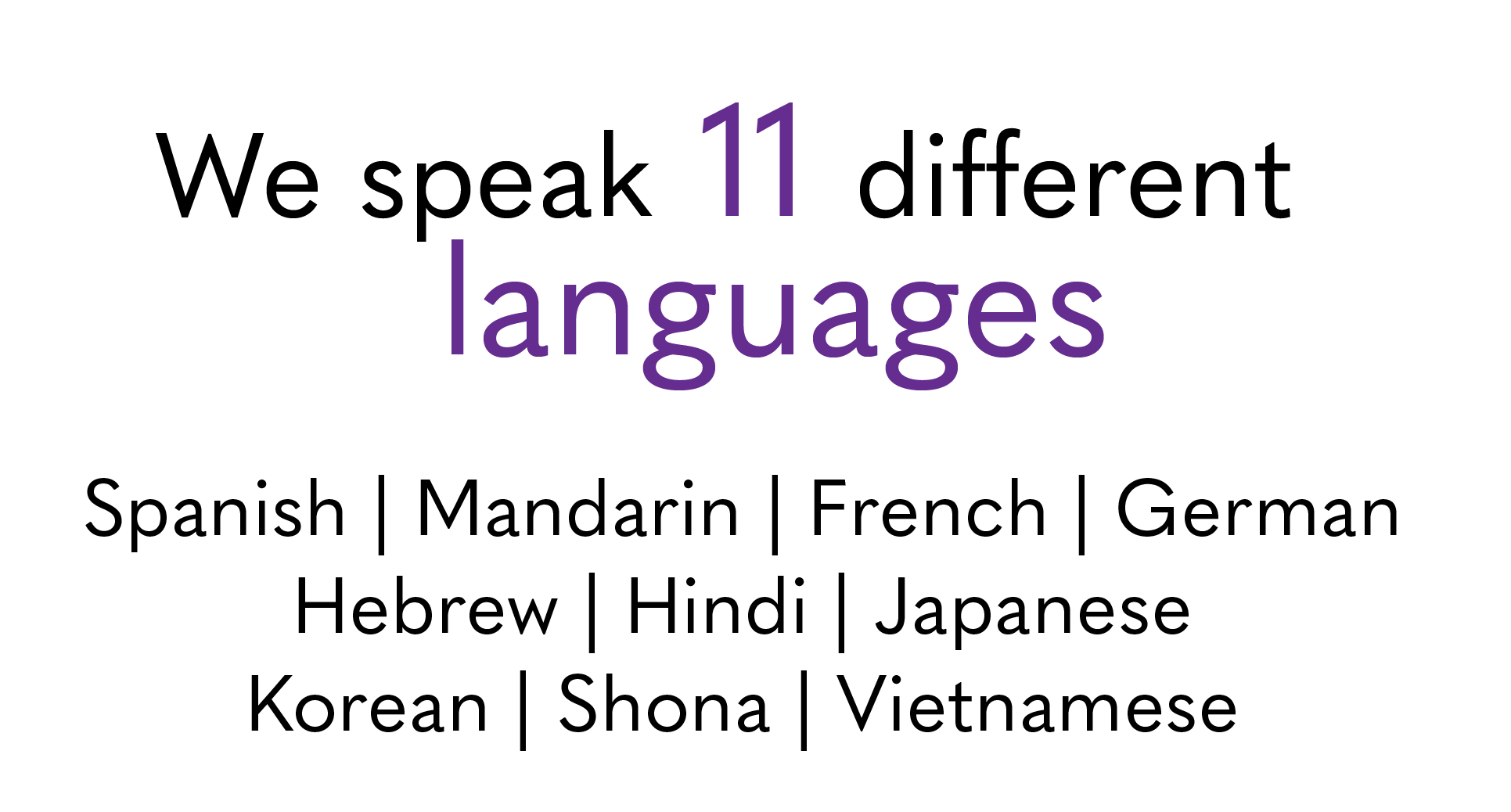For the second time, North by Northwestern is publishing a diversity report to maintain transparency and accountability about our newsroom composition. We regret that this report is late. We decided to hold the report until spring quarter so we could push the survey at section meetings one more time given that we had significantly fewer responses to our winter survey than our fall survey. In winter, 71 people responded to the survey, versus 101 responses in fall. We often lose staffers from fall to winter, so some of this is attributable to the usual decline. Some of it may also be attributable to usual nonresponse, amplified by the lateness of pushing this survey, but it is hard to know if we lost staffers or if they just didn’t answer the survey. Ideally, we will push this survey earlier in the quarter.
We acknowledge and appreciate the Daily Northwestern’s precedent of publishing a quarterly diversity report and for calling on other publications to do so. While the publication of a diversity report does not in itself help us become a more diverse and inclusive newsroom, we hope to hold ourselves accountable through this survey and through detailing our steps to make NBN a more representative and diverse newsroom and community.
For reference, roughly twice the number of people work for our web side than for our print side. Because of the overlap in print and web writers and editors, we chose not to differentiate among our two sides.
The survey: main takeaways
Race and ethnicity

The data collection method for race and ethnicity was more detailed than previous quarters. From the survey, we were able to see that our white-identifying staff increased from 40.6% to 42.2%. Whereas our Winter Quarter survey asked only for Asian American identification, this quarter we specified among South Asian, East Asian and Southeast Asian. Out of our staffers who identify as Asian, 17 identified as East Asian, three identified as South Asian and four identified as Southeast Asian. Three staffers who identified as Asian also identified as other races. Overall, the Asian American staff decreased slightly from 34.7% to 32.4%. The percentage of Black and/or African American identifying staff increased slightly from 2% to 2.8% but still remains dishearteningly low. We have clearly failed to create an environment that welcomes Black students, and we are going to take measures to rectify that.
For our Latinx and/or Hispanic staff, our data results were skewed between those identifying by race, i.e. white or Black, as well as Latinx and/or Hispanic ethnicity. But after comparing data, we have determined that our Latinx and/or Hispanic identifying staff increased from 13% last quarter to 16.7%. Of this 16.7%, nine people self-identified as both Latinx and/or Hispanic and white, while three people identified themselves as Latinx and/or Hispanic only. No staffers who filled out the survey identify as Middle Eastern and/or North African or Native Hawaiian or other Pacific Islander. As noted in the introduction, it is possible these results may not be entirely indicative of our diversity because of nonresponse, but we do not have a way of knowing.
Graphically, we are double counting people who identified as two or more races, but we are demonstrating that with the overlaid blue bar to avoid the impression that our staff is larger than it is. The blue bar overlaid on the purple bar represents people who identified as that race in addition to another race. While recognizing that being multiracial is inherently a unique experience, we wanted to show the racial and ethnic makeup of our newsroom with as much detail as possible for the sake of transparency.
First-generation and low-income
First generation students made up approximately 7% of North by Northwestern’s members, a 3.9% drop from last fall. Low-income students made up approximately 12.7% of our members, a 7.3% drop from fall. As we transition to living back on campus or near Northwestern’s campus, students who receive financial aid may be committing to in-person work-study positions, which could make it more difficult for them to participate in the publication. NBN strives to work with low-income students and provide accommodations for students who work, but we clearly need to do a better job.
Northwestern categorizes first generation and low-income students together under the umbrella acronym of “FGLI.” However, our survey asked for students’ statuses as first generation or low-income students separately to emphasize that these identities can exist together or independently from one another.
Gender identity

Our staff remains predominantly woman-identifying, with nearly three-quarters of our staff identifying as women. We have also seen an increase in gender non-conforming identities from fall quarter. However, direct comparisons are difficult to draw because of differences in our data collection method. In the Fall 2020 survey, we allowed students to write-in their gender identity, which led to us having to make categorization decisions after the fact. We grouped students into male, female, and genderfluid/gender-nonconforming/non-binary. This quarter, we gave students the option to select all that apply, with the option of specifying if they were cisgender or not. Not everyone who identified as men or women specified if they were cisgender, which created the categories of woman (unspecified) and man (unspecified).
In the fall, the results were Male 19.6% , Female 76.3% , genderfluid/gender-nonconforming/non-binary 4.1%. In the winter, the results were as follows: woman (unspecified) 47.9%,woman (cisgender) 25.4%, woman and non-binary 4.2%, man (cisgender) 9.86%, man (unspecified) 8.45%, non-binary 1.41%, agender 1.41%, genderfluid 1.41%.
Lastly, from the data, we note that there has been an increase in gender non-conforming identities in the NBN staff. Though this number may be larger because of the unspecified identities within the “man” and “women” options, gender non-conforming identities are around 8.5%, which is higher than the fall’s 4.1%. Moving forward, NBN will do our best to correct the inaccuracy of these unspecified identities and will aim to continue building a more gender-diverse and accepting community.
Sexual orientation

About 53% of our staff identifies as heterosexual and about 44% identifies as LGBTQ+. Two people identified as multiple sexualities and were counted across both categories. There were minor increases across all categories since fall due to an increase in survey participants answering the question (a decrease in nonresponse). NBN remains committed to cultivating an inclusive environment for LGBTQ+ individuals and ensuring there is LGBTQ+ representation on staff. It is important that our newsroom contains a diverse array of perspectives and identities, and we will continue to work on making certain this is a reality. We are going to work toward holding more affinity spaces for LGBTQ+ individuals on staff.
Languages

Our staffers speak fewer languages than in fall, but this is likely due to a drop in survey responses overall. There was a mostly negligible drop in languages spoken across all languages except for Mandarin Chinese, which dropped by 10%. Nearly a quarter of our staff speaks Spanish, followed by Mandarin and then French. Staffers listed eight other languages spoken: Hindi, Korean, Vietnamese, Japanese, Shona, Portuguese, German and Hebrew. In total, NBN staff speaks 11 languages other than English.
Religion
Out of the 71 respondents, 22 identified as Agnostic, and others identified as Agnostic along with another religious affiliation, a significant increase from fall. A significant number of respondents also identified as Christian (14), Atheist (11), Jewish (8), and None/Not Practicing (6). One respondent identified as Hindu and three did not answer the question, a decrease in nonresponse from last fall. More respondents described themselves as having multiple religious identities compared with fall. This survey used a select all the apply response option, as opposed to the long response option used in fall, so that we would not have to assign respondents to categories ourselves. As a result, it is difficult to discern percentage increases or decreases in different religion categories between fall and winter. However, it is apparent that NBN still does not represent the array of different religions on campus and will continue to work on diversifying our newsroom representation and coverage.
Next steps
To move forward and improve our diversity and inclusion efforts, we are implementing several changes to the way we collect demographic data and how we foster an inclusive newsroom. As mentioned above, we strive to be open to staffers about the low barrier to entry for NBN and the flexibility that allows them to be part of other campus organizations and hold work study jobs. We do not mean for NBN to take away from students’ academic, social or financial obligations or be a detriment to their wellness in any way. We hope that through communicating this message and by holding identity-based affinity spaces for staffers, we can bring a wider group of students to NBN.
We are hoping to reformat our survey to include questions that will give us the fairest representation of our staffers. In the future, instead of only asking for self-identifying low-income students, we will also be asking students to voluntarily identify if they receive financial aid. This will give a more accurate picture of our financial inclusivity. In addition, we are going to ask writers to specify if they speak languages other than English to avoid any confusion or excess data.
Another data collection change will be for the race and ethnicity section, in which we will be separating race and ethnicity as categories to allow for staffers, such as Latinx and/or Hispanic writers, to report any and all aspects of their identity as they choose. This will prevent future confusion in the data by avoiding the need to recategorize these staffers because of double counting. Every staffer at North by Northwestern should be able to report their identity without confusion. Because this is only our second time publishing a diversity report, regrettably, we are still working to improve our data collection process, and we hope to make comparisons across quarters easier once we have a more consistent method of asking survey questions.
Outside of the survey, we have other changes that we plan to implement in the publication. We are hoping to begin tracking the diversity of our sources. We want to begin using forms and surveys to track the demographics of our interviews, asking sources to voluntarily self-identify so that the publication remains accountable in our coverage. For the first quarter of implementing this at least, the information will likely only circulate internally.
Our empathetic and inclusive reporting training is being transformed into a more interactive dialogue, so editors and writers can both engage on a deeper level. This dialogue aims to be a space of reflection while also sending the message that diverse voices are not only necessary in BIPOC-centered stories, but in all stories and articles. We will also be working to increase our writer retention rates, hopefully with more in-person bonding activities and affinity spaces as we safely navigate this pandemic.
As a publication, North by Northwestern strives to have an inclusive newsroom with empathetic reporters. However, the purpose of striving for diversity is not to pigeonhole writers into only covering stories that correspond to their identities. Instead, we want to explore the role that identity, diversity and inclusion can play in our reporting, our decision-making and our overall environment. By releasing this quarterly report, we are attempting to hold ourselves accountable for the identities we represent and the ones that we do not represent enough.